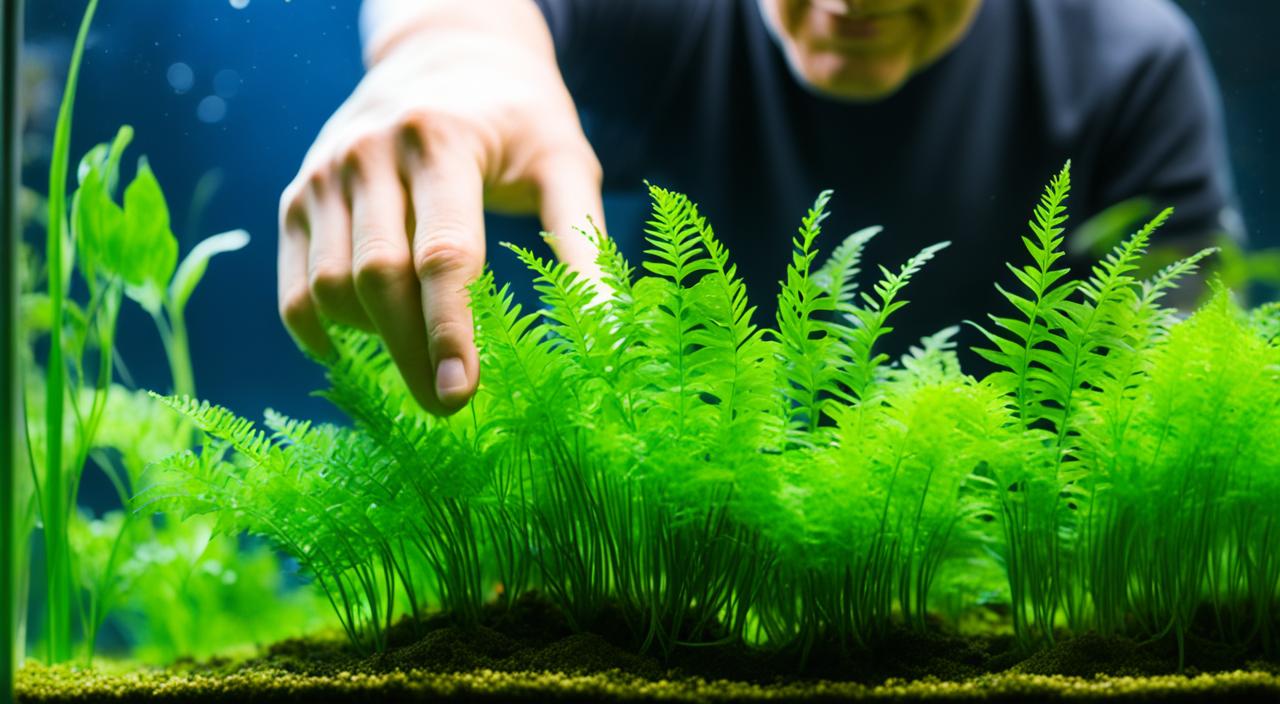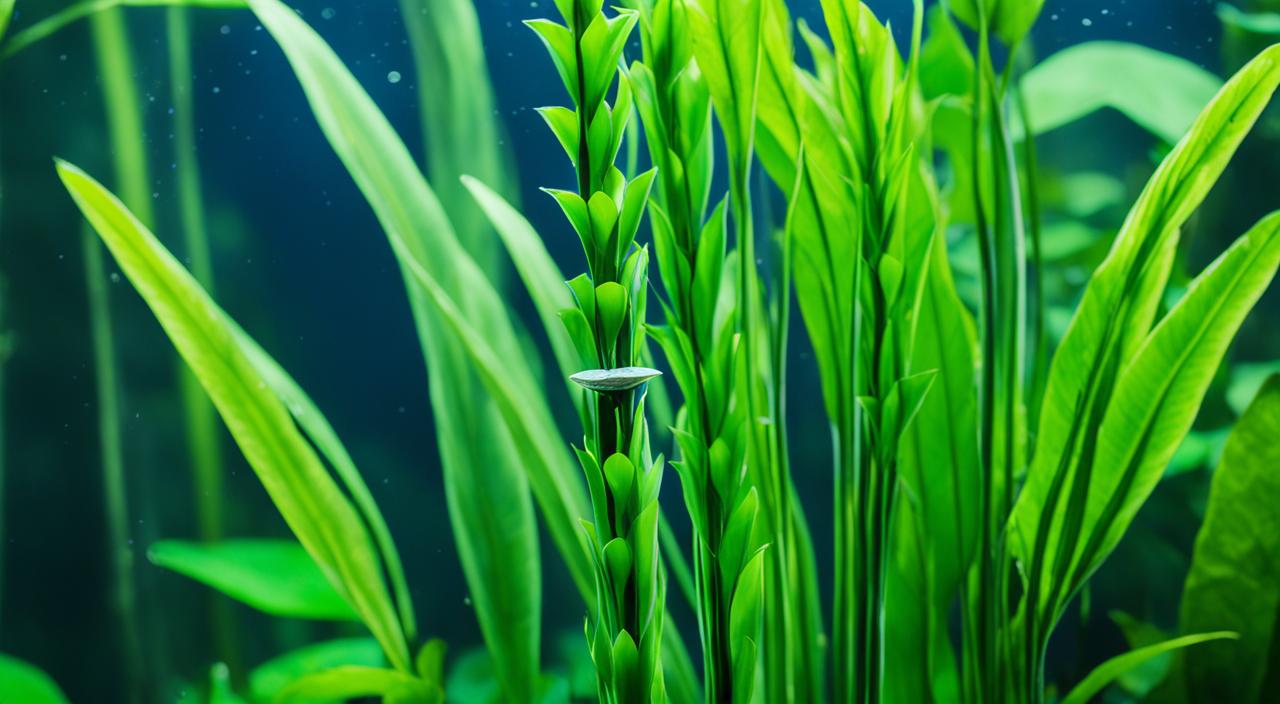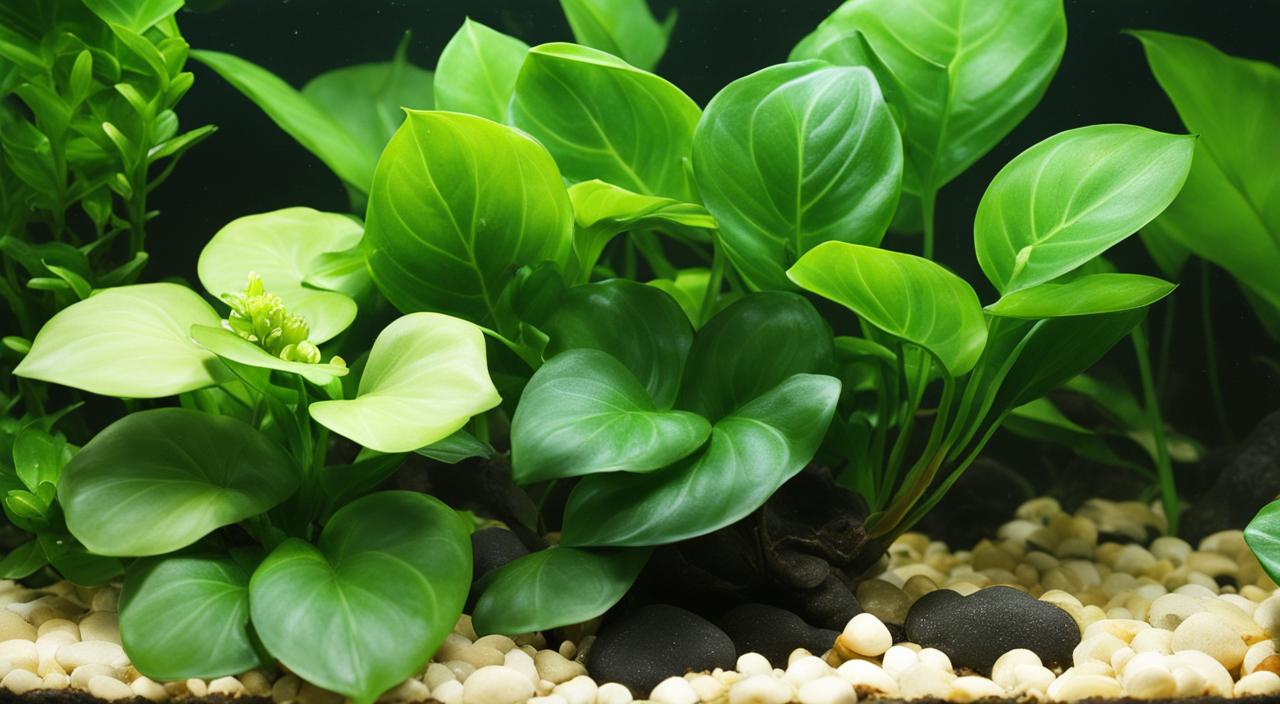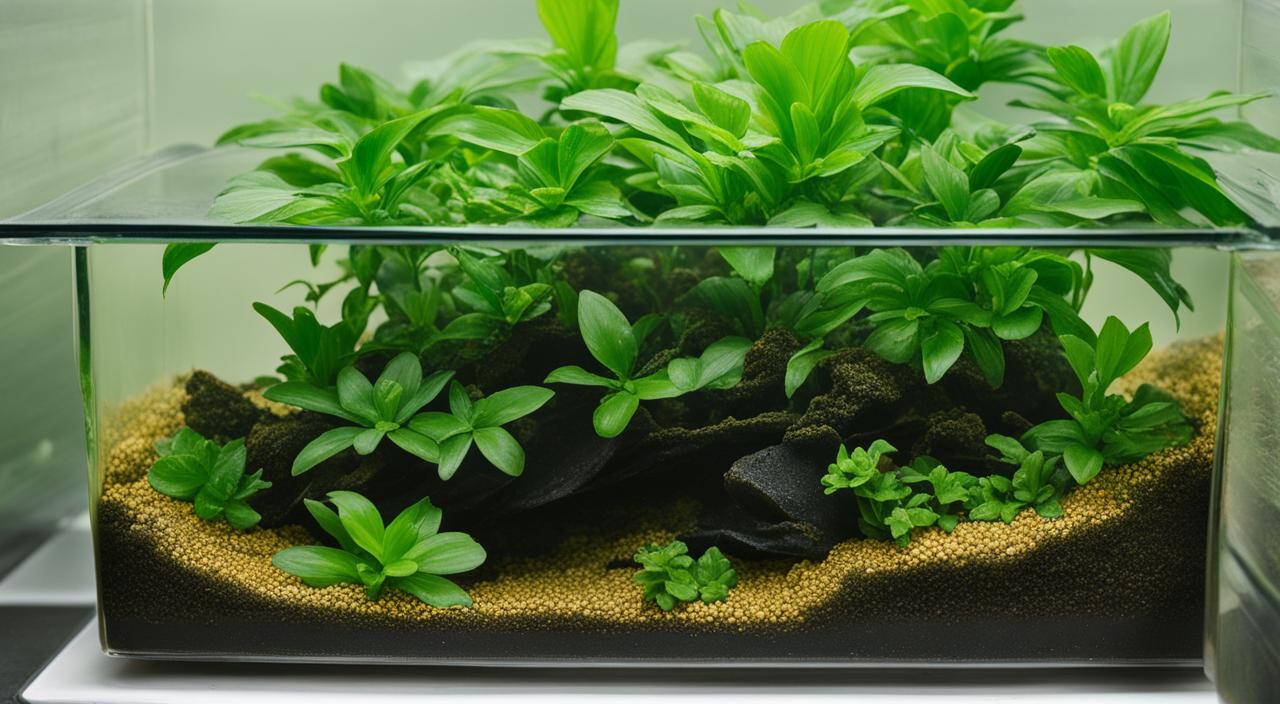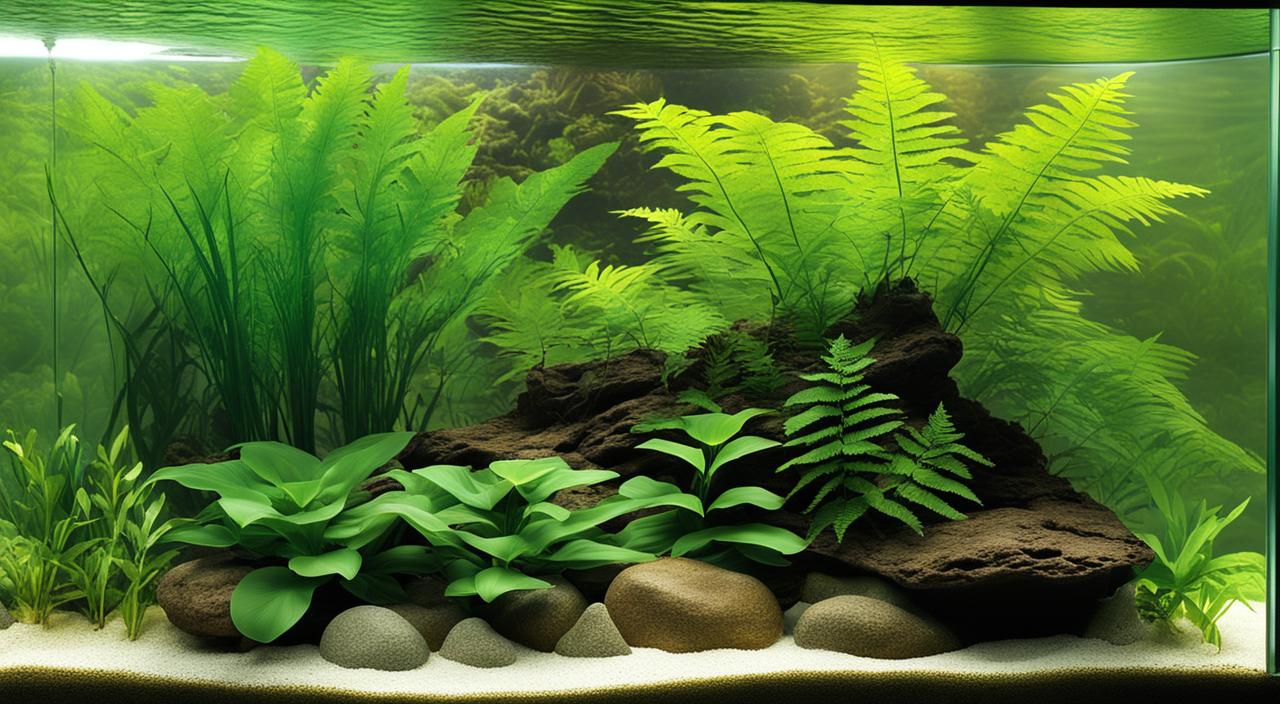As an aquatic enthusiast, I always look for beautiful, low-maintenance plants for my freshwater aquarium. One plant that has caught my attention is the Java Fern (Microsorum pteropus). Its unique leaf structure and ability to thrive in low light conditions make it an excellent choice for aquascaping enthusiasts and beginners.
When caring for Java Fern, you’ll be delighted to know that it is a hardy plant that can adapt to various lighting and water conditions. In this article, I will guide you through Java Fern care, propagation, and its use in aquascaping for thriving low-light aquarium plants.
Key Takeaways:
- Java Fern (Microsorum pteropus) is an easy-to-care-for aquatic plant that can thrive in low-light conditions.
- It is adaptable to various lighting and water conditions, making it a suitable choice for aquascaping.
- Java Fern can be created by separating the rhizomes or allowing the plant to produce baby plants independently.
- When used in aquariums, Java Fern provides shelter, grazing areas, and a natural-looking habitat for fish and invertebrates.
- Proper care, feeding, and maintenance are essential for the health and vibrancy of Java Fern in your aquarium.
Brief Overview Of Java Fern (Microsorum pteropus)
Java Fern is an epiphytic aquarium plant that uses thread or glue to attach to driftwood, rocks, or other aquarium decorations. It is important to keep the rhizome, the twig-like portion of the plant, above the substrate to prevent rotting. This plant is available in various varieties, including Java Fern Trident, Java Fern Needle Leaf, Java Fern ‘Windelov’, Java Fern Narrow Leaf, and more. It is known for its slow growth rate and can create a lush and natural look in aquariums.
Table for Plant Species:
| Attribute | Java Fern (Microsorum pteropus) |
|---|---|
| 1. Scientific Name: | Microsorum pteropus |
| 2. Common Names: | Java Fern |
| 3. Origin: | Southeast Asia |
| 4. Height: | 20-30 cm (8-12 inches) |
| 5. Growth Rate: | Slow |
| 6. Colour: | Dark green |
| 7. Aquarium Placement: | Midground to Background, attached to hardscape (rocks, driftwood) |
| 8. Water Type: | Freshwater |
| 9. pH: | 6.0 – 7.5 |
| 10. Care Level: | Easy |
| 11. Light Requirements: | Low to moderate. Prefers 50-200 PAR, LUX around 2000-5000, best in 6500K-7500K Kelvin scale for optimal growth. |
| 12. CO2 Requirements: | Primarily photosynthetic, it benefits from liquid fertilizers and micronutrients, especially if not rooted in the substrate. |
| 13. Temperature: | 20-28°C (68-82°F) |
| 14. Flow Rate: | Low to moderate. Prefers gentle water movement. |
| 15. Propagation: | Rhizome division or adventitious plantlets on leaf tips. |
| 16. Feed Type: | Primarily photosynthetic, benefits from liquid fertilizers and micronutrients, especially if not rooted in the substrate. |
Origins And Habitat
The Java Fern, known scientifically as Microsorum pteropus, is native to Southeast Asia, specifically Java, Sumatra, and Borneo. This versatile aquatic plant grows along the banks of rivers and streams and on rocks and fallen branches. Its natural habitat includes submerged and emersed environments, allowing the Java Fern to adapt and thrive in various water conditions.
The Java Fern is well-suited to shaded areas with low to moderate light levels. Its ability to grow in such environments makes it ideal for aquariums with low-light setups.
| Variety | Description |
|---|---|
| Java Fern Trident | Characterized by its triple-lobed leaves, adds an interesting texture to the aquarium. |
| Java Fern Needle Leaf | Has thin, needle-like leaves that create an elegant and delicate appearance. |
| Java Fern ‘Windelov’ | Named after the Danish aquarist Tropica, who first discovered it. Features finely branched leaves. |
| Java Fern Narrow Leaf | Has narrow, elongated leaves that add a unique shape to the aquarium. |
Morphological Characteristics
Java Fern is easily recognizable due to its unique leaf structures. Its leaves are dark green and leathery and possess long, narrow leaflets that are lobed or undulated. This distinctive leaf structure contributes to the plant’s aesthetic appeal and adds visual interest to aquariums.
Additionally, Java Fern features a rhizome, which is crucial for plant growth and propagation. The rhizome is a horizontal stem that grows above the substrate, producing roots, leaves, and new plantlets. It is a vital connection between the plant and its environment, allowing nutrients and water to flow through the system.
The rhizome of the Java Fern should not be buried beneath the substrate. If buried, it can lead to rotting and decline the plant’s overall health. Maintaining the rhizome above the substrate is essential to ensure the Java Fern thrives and continues to develop new leaves and plantlets.
Placement And Lighting
When placing Java Fern in your aquarium, you have several options. This versatile plant can be attached to driftwood, rocks, or other decorations using thread or glue. Alternatively, you can let it float freely in the water, adding a natural and dynamic element to your aquatic environment.
One of the reasons Java Fern is so popular among aquarists is its ability to adapt to a wide range of lighting conditions. It is primarily known as a low-light plant, thriving in environments with minimal light. However, it can also tolerate medium-high light levels as long as it is not too intense. Excessive light can burn or melt the leaves, negatively impacting the plant’s health and appearance.
To ensure optimal growth, it is recommended to use a 6700k spectrum bulb for lighting your tank. This spectrum closely mimics natural daylight and provides the right balance of light for Java Fern. It is essential to find the right intensity and duration for your specific setup, considering factors such as tank size, light output, and the needs of other plant species in your aquarium.
Java Fern is a fantastic choice for low-light aquarium setups, as it can thrive and add beauty to your tank without requiring high-intensity lighting. Its adaptability and ability to grow in diverse lighting conditions make it a favourite among beginner and experienced aquarists.
What Are Good Tank Mates?
When selecting tank mates for your Java Fern aquarium, choosing fish that can coexist peacefully and complement the plant’s natural habitat is important. Java Fern provides shelter, grazing areas, and a visually appealing environment for many aquarium inhabitants. However, certain fish species should be avoided due to their aggressive behaviour or tendency to uproot plants, which can potentially damage or destroy your Java Fern.
Good Tank Mates
Some of the compatible tank mates that can coexist harmoniously with Java Fern include:
- Tetras, such as Neon Tetras, Cardinal Tetras, and Ember Tetras
- Rasboras, like Harlequin Rasboras and Chili Rasboras
- Corydoras Catfish, such as Bronze Corydoras and Pygmy Corydoras
- Shrimp, including Cherry Shrimp and Amano Shrimp
- Other peaceful community fish like Guppies, Swordtails, and Otocinclus Catfish
Fish Species To Avoid
It is recommended to avoid certain fish species that may pose a threat to your Java Fern or create an unfavourable environment. These fish species are:
- Aggressive Cichlids, such as Oscars and Convict Cichlids
- Large Goldfish that tend to uproot plants
- Some Barbs, like Tiger Barbs and Rosy Barbs, are known for their fin-nipping behaviour
- Fast-swimming and aggressive fish like Tiger Oscars and Jack Dempsey
Feeding (Fertilization)
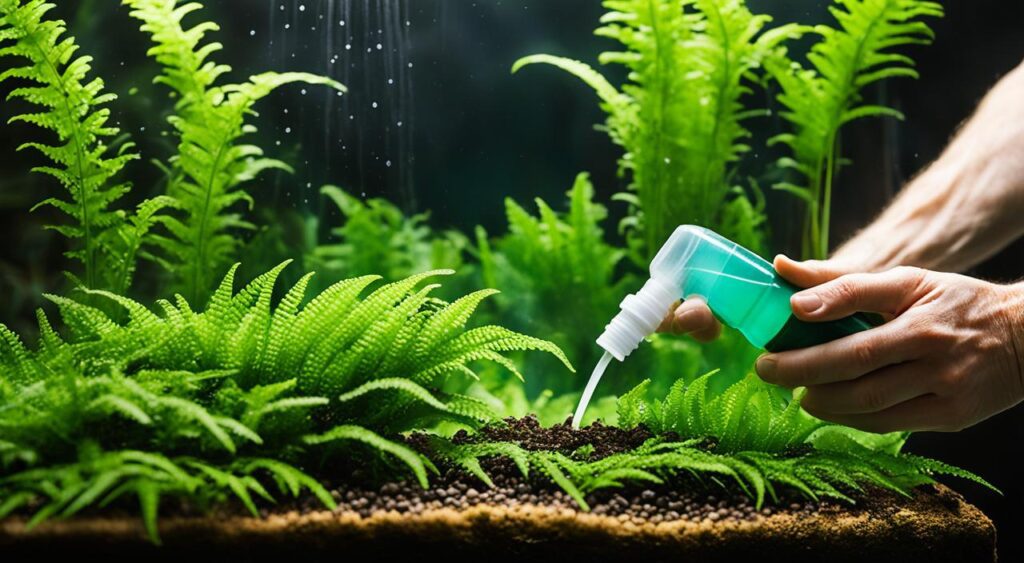
Java Fern is a hardy plant that does not have high nutrient requirements. It can obtain nutrients from the water column and substrate. While it does not necessarily need additional fertilization, providing a well-balanced liquid fertilizer can promote healthier growth and vibrancy in the leaves. Following the manufacturer’s instructions and dosing the fertilizer according to the aquarium size and plant density is essential. Overfertilization can lead to algae growth, so it is crucial to find the right balance.
CO2 Injection
CO2 supplementation can greatly benefit Java Fern in planted aquariums, although it is not strictly necessary for its growth. Adding carbon dioxide (CO2) can enhance the overall health and appearance of the plant, promoting lush and vibrant growth. Several CO2 injection methods are available for aquarium plants, including compressed gas systems, liquid carbon supplements, and DIY yeast-based setups.
Compressed gas systems, such as CO2 cylinders or tanks, are commonly used in larger aquarium setups. These setups regulate the flow of CO2 from the cylinder through a diffuser into the water, providing a steady supply of carbon dioxide to the plants.
Liquid carbon supplements, like liquid CO2 or glutaraldehyde-based products, are famous for smaller aquariums or setups with lower light levels. These supplements provide a readily available plant carbon source and can be efficiently dosed according to the manufacturer’s instructions.
DIY yeast-based setups involve creating a homemade CO2 generation system using yeast, sugar, and water. This setup produces carbon dioxide as a byproduct of yeast fermentation. While DIY setups can be cost-effective, they may require closer monitoring and maintenance.
Regardless of the CO2 injection method chosen, it is essential to carefully monitor the CO2 levels in the aquarium and adjust the injection rate accordingly. Proper CO2 levels are crucial for the health and growth of Java Fern and other aquatic plants in the tank. Excessive or insufficient CO2 can lead to imbalances in the planted aquarium, affecting the overall well-being of the plants and the ecosystem as a whole. Regular water parameter testing and observing the plants’ response to CO2 supplementation will help ensure optimal conditions for Java Fern and other aquarium plants.
Care
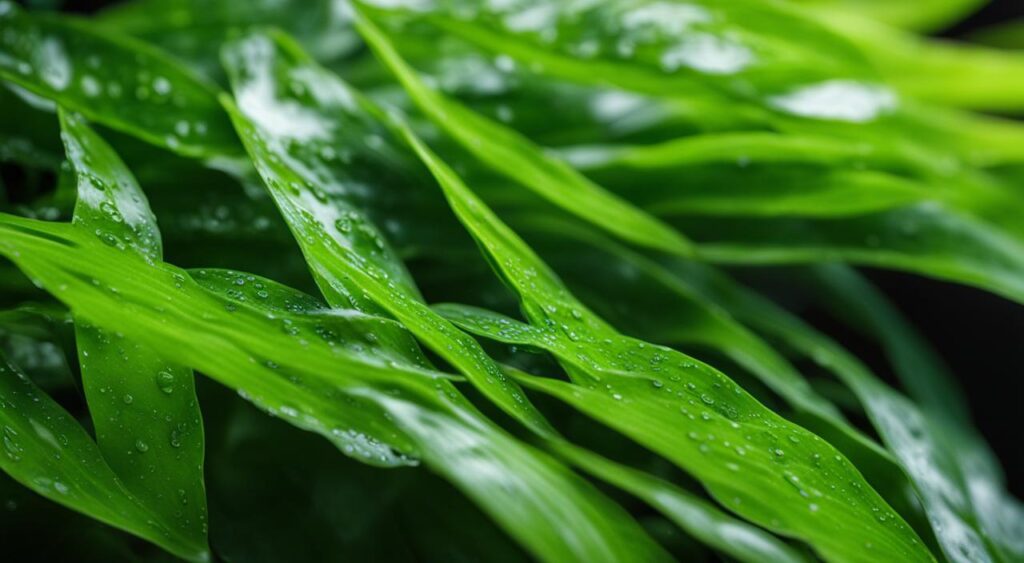
Proper care is essential for the health and growth of Java Fern. It is a hardy plant that can tolerate a range of water parameters.
Planted Tank Parameters
When setting up a planted tank for Java Fern, it is crucial to consider the following parameters:
- Water temperature: Maintain a temperature range between 68-82°F (20-28°C) to ensure optimal growth.
- pH level: Keep the pH range between 6.0 and 7.5 for suitable conditions.
- Substrate choice: Java Fern is versatile and can grow attached to decorations or bare-bottom tanks, so substrate choice is not critical.
Water Quality
In order to provide optimal water quality for Java Fern, it is essential to maintain stable water conditions and avoid drastic parameter fluctuations. Regular testing of water parameters, such as ammonia, nitrite, nitrate, and pH levels, is recommended. This will help ensure a healthy environment for the plant to thrive.
Filtration
Proper filtration is essential for maintaining water quality and keeping the planted aquarium clean. Choose a filtration system that provides gentle water flow to prevent damage to the delicate leaves of Java Fern. The filtration system should effectively remove debris and maintain clear water.
Flow
Water flow is another crucial factor to consider when caring for Java Fern. Aim for a moderate water flow in the aquarium to prevent stagnation and promote adequate nutrient distribution. Too strong of a water flow can damage the plant’s leaves, so it is essential to find the right balance.
Implementing these care tips, understanding the planted tank parameters, maintaining optimal water quality, choosing suitable filtration, and ensuring proper water flow will contribute to the overall health and success of Java Fern in your aquarium.
Aquarium Maintenance
Testing Water Conditions
Regular testing of water parameters is essential to maintain the well-being of your Java Fern and ensure a healthy aquatic environment. Regularly testing the pH, ammonia, nitrite, and nitrate levels in your aquarium is recommended. This will allow you to monitor the health and quality of the water and make any necessary adjustments to keep it within optimal range for your Java Fern.
How To Set Up Your Aquarium Tank
Properly setting up your aquarium tank is crucial for the successful growth of your Java Fern. Here are some essential steps to follow:
- Lighting: Choose a suitable lighting system for your tank. Java Fern thrives in low to medium-high light conditions, so ensure that your lighting setup provides the right light intensity.
- Water Conditions: Maintain appropriate water parameters for your Java Fern. It prefers a temperature between 68-82°F (20-28°C) and a pH range of 6.0-7.5. Keep the water clean and free from harmful substances.
- Decorations: Select rocks, driftwood, or other aquarium decorations to attach your Java Fern. It can be glued or tied to these structures using thread or fishing line, ensuring the rhizome remains above the substrate.
- Substrate: While substrate choice is not critical for Java Fern, providing a nutrient-rich substrate to support its growth can be beneficial. Alternatively, you can attach the plant to decorations without using any substrate.
Propagation Methods
Propagating Java Fern is a simple and rewarding process. There are two primary methods for propagation:
- Rhizome Division: Gently separate the rhizome of a mature Java Fern into smaller sections. Each section should have at least a few leaves and roots. Plant these sections in suitable locations, and they will grow into individual plants.
- Natural Propagation: Java Fern can produce baby plants on its own. These are known as plantlets and develop at the tips of the leaves. Once the plantlets have grown a few roots, they can be carefully detached from the parent plant and planted in desired locations.
Health And Disease
Maintaining Java Fern’s health involves regular observation and prompt action in case of any issues. By recognizing good or poor health signs, you can identify potential problems and take appropriate measures to keep your Java Fern thriving.
Signs Of Good Health
A healthy Java Fern exhibits several characteristics:
- Vibrant and green leaves
- New growth, including the emergence of baby plants
- Active propagation with the development of new rhizomes
Regularly inspect your Java Fern to ensure these signs of good health are present. A flourishing Java Fern indicates proper care and a conducive environment.
Signs Of Poor Health
On the other hand, there are several signs that your Java Fern may be experiencing poor health:
- Discoloration or yellowing of the leaves
- Rotting rhizomes or roots
- Stunted or slow growth
If you notice any of these signs, it is vital to promptly investigate and address the underlying issues to prevent further decline.
Common Health Issues And Treatment
Common health issues in Java Fern can include:
- Nutrient deficiencies, such as iron or potassium
- Algae overgrowth, leading to reduced plant health
- Bacterial or fungal infections
To treat these health issues in Java Fern, consider the following actions:
- Monitor and adjust water parameters to ensure optimal conditions
- Provide proper nutrition through liquid fertilizers or substrate additives
- Introduce targeted treatments for bacterial or fungal infections
Addressing these common health issues promptly can help restore your Java Fern to good health.
Plant Pests
Java Fern can also be affected by various plant pests that can damage the leaves or rhizomes. Common pests that may affect Java Fern include:
- Algae, which can cover the leaves and inhibit growth
- Snails, which can eat the leaves or lay eggs on the plant
- Pests that can physically damage the rhizome or roots
Regularly inspect your Java Fern for signs of pests and take appropriate measures to control their population. This may include removing affected leaves or introducing natural predators, such as snail-eating fish or invertebrates.
By actively monitoring the health of your Java Fern and taking prompt action when needed, you can help ensure this popular aquarium plant’s continued vitality and beauty.
| Health Issue | Treatment |
|---|---|
| Nutrient deficiencies | Adjust water parameters and provide appropriate fertilization |
| Algae overgrowth | Control lighting duration and intensity, introduce algae-eating fish or invertebrates |
| Bacterial or fungal infections | Apply targeted treatments, such as aquarium-safe medications |
Summary
In summary, Java Fern (Microsorum pteropus) is a versatile and popular aquatic plant known for its resilience and ease of care. This plant can thrive in low light conditions and accommodate a wide range of water parameters, making it suitable for various aquarium setups. Whether used in planted aquariums or as a natural decoration, Java Fern offers beauty and functionality.
With its unique leaf structure and slow growth rate, Java Fern can create a lush and natural look in any aquarium. It is an excellent choice for both beginner and experienced aquatic enthusiasts. Proper care, feeding, and maintenance are essential for the health and growth of Java Fern.
By providing suitable lighting, adjusting water conditions, and following basic care guidelines, you can ensure the longevity and vibrancy of your Java Fern. This versatile plant adds aesthetic appeal and contributes to the overall balance of the aquatic environment. Consider incorporating Java Fern into your aquarium to enhance its visual appeal and provide a natural habitat for your aquatic inhabitants.
FAQ
What is Java Fern (Microsorum pteropus)?
Java Fern is a popular and easy-to-care-for aquatic plant used in planted aquariums. It is known for its unique leaf structure, slow growth, and ability to thrive in various lighting and water conditions.
What are the different varieties of Java Fern?
Java Fern is available in various varieties, including Java Fern Trident, Java Fern Needle Leaf, Java Fern ‘Windelov’, Java Fern Narrow Leaf, and more.
Where is Java Fern native to?
Java Fern is native to Southeast Asia, specifically Java, Sumatra, and Borneo, where it grows along the banks of rivers and streams, as well as on rocks and fallen branches.
How should I place and light my Java Fern?
Java Fern can be attached to driftwood, rocks, or other decorations in your aquarium. It is adaptable and can tolerate a wide range of lighting conditions, from low to medium-high light levels.
What are good tank mates for Java Fern?
Java Fern is a versatile plant that can coexist with a wide range of fish species, including tetras, rasboras, corydoras catfish, and shrimp. However, it is important to avoid aggressive fish species or those that have a tendency to uproot plants.
How do I fertilize Java Fern?
Java Fern does not have high nutrient requirements but can benefit from a well-balanced liquid fertilizer. It is important to follow the manufacturer’s instructions and dose the fertilizer according to the aquarium size and plant density.
Should I use CO2 supplementation for Java Fern?
CO2 supplementation is not a strict requirement for the growth of Java Fern, but it can enhance its overall health and appearance. Different types of CO2 injection methods, such as compressed gas systems or liquid carbon supplements, can be used.
What care does Java Fern need?
Java Fern is a hardy plant that can tolerate a range of water parameters. It thrives in water temperatures between 68-82°F (20-28°C) and a pH range of 6.0-7.5. Regular aquarium maintenance, including water testing and providing suitable lighting and water conditions, is necessary for its well-being.
How do I maintain my aquarium with Java Fern?
Regular aquarium maintenance includes testing water parameters, setting up the tank appropriately, and propagating Java Fern. It is important to monitor water quality and address any health issues promptly.
What are some common health issues in Java Fern?
Common health issues in Java Fern can include nutrient deficiencies, algae overgrowth, and bacterial or fungal infections. Prompt treatment and appropriate actions, such as adjusting water parameters or using targeted treatments, can help address these issues.
How do I propagate Java Fern?
Java Fern can be propagated by separating the rhizomes or allowing the plant to produce baby plants on its own. The propagation process is relatively simple and can help expand your Java Fern collection.
Can Java Fern be affected by plant pests?
Yes, Java Fern can be affected by plant pests such as algae and snails. These pests can damage the leaves or rhizome of the plant. Taking appropriate measures to control these pests is important for the health of your Java Fern.
What are the key takeaways about Java Fern?
Java Fern (Microsorum pteropus) is a versatile and popular aquatic plant known for its resilience and ease of care. It can thrive in low light conditions and accommodate a wide range of water parameters. With proper care, feeding, and maintenance, Java Fern can provide a lush and natural look to any aquarium.

